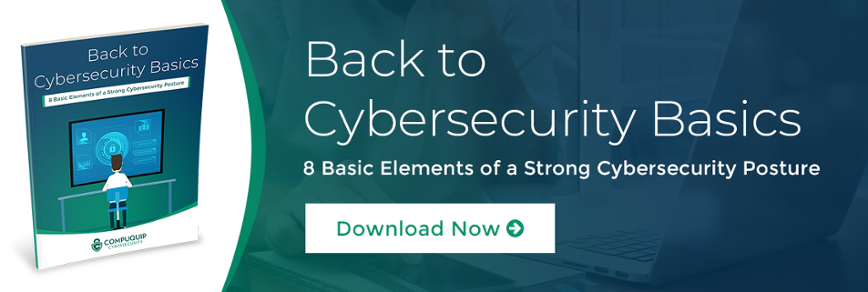The 6 Cybersecurity Building Blocks Everyone Needs
While different companies may have different cybersecurity needs based on their industry and size, there are a few basic things that every organization, regardless of size and focus, should include in their cybersecurity architecture.
What are these cybersecurity basics? And, how do they benefit your business’ security posture?
Cybersecurity Building Block #1: Network Security
Every organization needs to have a network security device (i.e. a firewall) to filter traffic. Firewalls inspect incoming and outgoing data packets for signs of abnormal or potentially malicious requests or data.
Virtually every business uses some type of firewall to protect itself. Some businesses even use multiple firewalls at the network perimeter, per-asset, and per-app levels to create a defense-in-depth strategy that limits the movement of cyber threats.
Firewalls are a very basic component of any security architecture, and no business should be without them.
Cybersecurity Building Block #2: Endpoint Security
Another basic building block of any cybersecurity architecture is the endpoint security agent. Endpoint security can take many forms, including antivirus/antimalware programs and individual device firewalls. The goal of an endpoint security agent is to provide protection for individual assets on the network.
Endpoint security agents help businesses protect individual assets on their network even after an attacker has breached external security measures. They help to bolster a defense-in-depth strategy by slowing down attackers or even providing an additional point where intrusion attempts may be detected.
Cybersecurity Building Block #3: Incident/Information Management
Many cybersecurity tools are designed to collect data about events like unusual access requests, denied traffic, and even if/when certain databases are altered. However, this data may not always be collated and organized in a convenient and easy-to-read manner.
Incident and information management tools, such as security information and event management (SIEM) can be a crucial part of any cybersecurity architecture by correlating various kinds of data into a single resource. Even with a security information and event management software, companies still may be presented with a lot of “noise”—information that is unnecessary and only serves to consume the time spent managing it.
This is why many organizations opt for a co-managed SIEM solution. With co-managed SIEM, companies can leverage the experience of a cybersecurity service provider to sift through the data and point out the most important information that needs to be acted on.
Cybersecurity Building Block #4: Service Infrastructure Components for Cloud
Many businesses are migrating their network infrastructure needs to the “cloud.” The use of Infrastructure-as-a-Service (IaaS) allows companies to almost instantly expand their computing resources for a fraction of the cost of adding physical infrastructure internally.
However, service infrastructure providers are generally not responsible for the security of any information that is processed or kept on their cloud-based assets—they simply serve as data centers This means that organizations need to find ways to translate their on-premise security tools for use in their cloud environments. Or, they can acquire new security tools (possibly from the same vendors) to protect their cloud service infrastructure.
Cybersecurity Building Block #5: Vulnerability Management
No matter what security measures and technologies a business uses, there will always be some kind of vulnerability. As a matter of fact, software developers are constantly revising their products to close newly-discovered security vulnerabilities.
So, for any business, a critical element of a strong security posture is engaging in continuous vulnerability management themselves. This includes activities such as running vulnerability assessments and penetration tests. These activities help to identify potential vulnerabilities in a cybersecurity architecture.
Once vulnerabilities have been identified, solutions to manage them can be implemented. Of course, the nature of the fix will change depending on the type of vulnerability identified.
Cybersecurity Building Block #6: Security Education, Training, and Awareness
In any security architecture, there is always one crucial security vulnerability: the people who are using the network and its assets. Many employees lack the foundational cybersecurity knowledge needed to effectively avoid cyber threats online. Even those employees who do know their cybersecurity basics may not follow the rules when they’re busy trying to get work done and their training was more than two years ago.
So, it’s important to enact a security education, training, and awareness (SETA) program to make sure that every employee:
- Is up to date with the latest cybersecurity information;
- Understands the potential dangers of not following cybersecurity best practices; and
- Receives periodic reminders that cybersecurity is an important issue.
A true SETA program is never a “one-and-done” solution. Instead, it’s a continuous effort that is worked into employee onboarding and periodic training sessions to ensure that everyone has the same level of cybersecurity awareness and knowledge.
These are the primary cybersecurity building blocks that every business needs to address sooner or later. However, there may be additional cybersecurity elements that your business needs to address, such as regulatory compliance.
If you have any questions about cybersecurity basics, be sure to speak to one of the experts on the Compuquip Cybersecurity team! Or, check out the Cybersecurity Basics guide at the link below:

